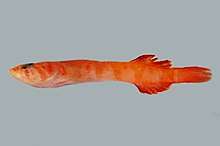Kopua
Kopua is a genus of clingfishes found in the Pacific Ocean.
| Kopua | |
|---|---|
 | |
| A Deepwater Clingfish, Kopua kuiteri, found in an empty shell trawled off Bermagui, New South Wales - depth 305-311 m | |
| Scientific classification | |
| Kingdom: | Animalia |
| Phylum: | Chordata |
| Class: | Actinopterygii |
| Order: | Gobiesociformes |
| Family: | Gobiesocidae |
| Subfamily: | Gobiesocinae |
| Genus: | Kopua Hardy, 1984 |
| Type species | |
| Kopua nuimata Hardy 1984[1] | |
Kopua are a genus of clingfishes belonging to the family Gobiesocidae. Fish belonging to this genus are found in the Pacific Ocean, around New Zealand, Australia, and the East China Sea.[2][3] The genus got its name “Kopua” from the Maori language; the name literally means “deep water”.[2] There are currently four known species of the genus:[3] Kopua numinata found in the northern waters of New Zealand, Kopua kuiteri found in southern Australian waters, Kopua japonica found in the East China Sea, and Kopua vermiculata found in the Sagami-nada Sea. The presence of Kopua in the Northern Hemisphere shows evidence of anti tropicality of fish within the family Gobiesocidae.[4] All species are found in waters deeper than 90m, ranging from 90m–408m in depth.[3] The genus was discovered through a trawling net of the ocean floor.[4] Not much is known about the genus’ habitat, except for the depth that the fish generally seem to reside, or the diet and behavior of the fish.
Description
Similar to other clingfishes, Kopua have small bodies with maximum lengths of 7 cm.[3] There is no observable sexual dimorphism in the recognized species.[2] All clingfish species have naked skin (scaleless), single dorsal and anal fins, a depressed head, as well as a pair of fin girdles that form the ventral sucking disk.[3] Fish that are part of the genus Kopua can be identified by specific shared characteristics, although each species does have varying measurements of each characteristic.[2][3] It is possible to distinguish species within the genus from each other by looking at the pore patterns and numbering and patterns of the anal and dorsal fins.[4] Fish within this genus have a slender body with a slender, depressed head and a short rounded snout, tubular nostrils on each side of the head that are free of a dermal flap and large eyes with narrow bony interorbit. They have a united gill membrane (no isthmus) fused opposite of the fourth pectoral ray, four gill arches with rakers and filaments; rakers are short and pointed.[2] They have a pore system, but it is only on the head of the fish.[2] The mouth is marginally inferior with a broad upper lip that barely narrows at the sides; there are two layers of teeth on the upper and lower jaw with the outermost layer teeth being flattened and rounded, the innermost layer are smaller, curved, and pointed, and the irregularly sized teeth along the side of the jaw.[2] Their dorsal and anal fins are moderately long and free from the caudal fin; they do not overlap the caudal fin base.[2][3] The double pelvic disc is striated with a square posterior fringe.[2] Kopua do not have a fleshy pactoral pad, and have a depressed posterior. Most species have an orangey-reddish pigmentation, but that is in death. The actual pigmentation of live fish is currently unknown.[2]
Species
There are currently 5 recognized species in this genus, although Fishbase currently only recognises 3:[5]
- Kopua japonica G. I. Moore, Hutchins & Okamoto, 2012 (Japanese deepwater clingfish)
- Kopua kuiteri Hutchins, 1991
- Kopua nuimata Hardy, 1984
- Kopua vermiculata Shinohara & Katayama, 2015 (Twilight clingfish) [3]
- Kopua yoko Fujiwara, Okamoto & Motomura, 2018[6]
References
- Eschmeyer, W. N.; R. Fricke & R. van der Laan (eds.). "Kopua". Catalog of Fishes. California Academy of Sciences. Retrieved 10 June 2019.
- Hardy, Graham S. (1984). "A new genus and species of deepwater clingfish (family Gobiesocidae) from New Zealand". Bulletin of Marine Science. 32 (2): 244–247.
- Shinohara, Gento; Katayama, Eri (2015). "A new species of the clingfish genus Kopua (Gobiesociformes: Gobiesocidae) from Japan". Ichthyological Research. 62 (4): 431–438. doi:10.1007/s10228-015-0456-9.
- Moore, G.I; Hutchins, J.B.; Okamato, M. (2012). "A new species of deepwater clingfish genus Kopua (Gobiesociformes: Gobiesocidae) from the East China Sea–an example of antitropicality?". Zootaxa. 3380: 34–38. doi:10.11646/zootaxa.3380.1.2.
- Froese, Rainer and Pauly, Daniel, eds. (2019). Species of Kopua in FishBase. April 2019 version.
- Kyoji Fujiwara; Makoto Okamoto; Hiroyuki Motomura (2018). "Review of the clingfish genus Kopua (Gobiesocidae: Trachelochisminae) in Japan, with description of a new species". Ichthyological Research. 65 (4): 433–453. doi:10.1007/s10228-018-0633-8.